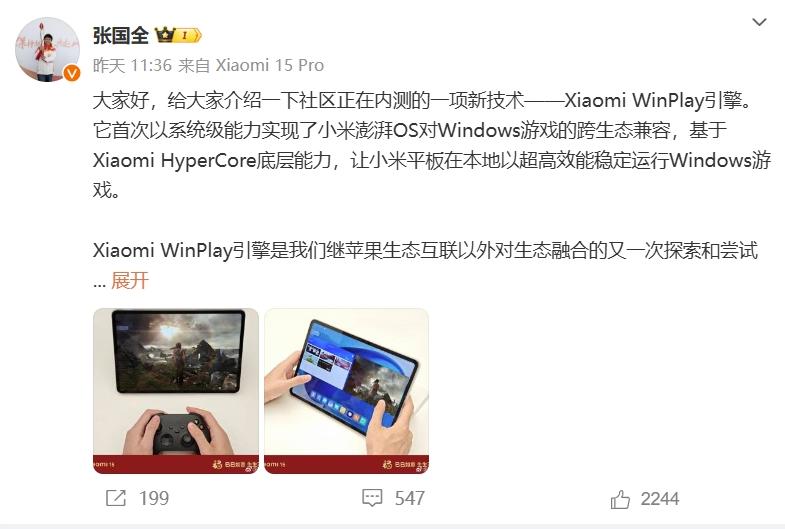The tablet supports the installation of Steam, and Xiaomi is eyeing console games.
Text | Xue Dexing
Editor | Liu Shiwu
In early 2025, Xiaomi has brought a new topic of discussion to the console gaming circle.
On January 21, Xiaomi officially announced that it will start the internal test of the WinPlay engine, allowing its tablets with ARM architecture SoC to install Steam and enjoy console games. The first batch of internal tests only supports one product, the XiaomiPad 6S Pro 12.4.
Zhang Guoquan, the director of the Xiaomi Mobile Phone System Software Department, said that the Xiaomi WinPlay engine is a new technology in the internal test stage. Through three-layer virtualization technology, this engine can achieve cross-platform compatibility of Pengpai OS for Windows games. It can install and download local games on Steam and support the connection of gamepads/keyboards and mice.
Image source: Weibo
Zhang Guoquan stated that after virtualization by this engine, the GPU performance loss of the Xiaomi Pad 6S Pro 12.4 is only 2.9%, and it can run "Tomb Raider 9" at an average frame rate of 45, basically achieving the experience of running native mobile games. It is worth mentioning that the processor equipped with this tablet is the Snapdragon 8 Gen 2, and the 16GB + 1TB configuration is priced at around 4,000 yuan on JD.com. For most small games on the PC side and some indie games, the performance of the current mobile terminal processor is completely sufficient.
The Xiaomi WinPlay engine has now started the internal test in the Xiaomi community. The first batch of internal tests is only for Xiaomi Pad 6s Pro 12.4 users, and there is no plan for an official launch in the short term.
Image source: Xiaomi
To play PC games on the mobile terminal, the solutions on the market also include cloud gaming technology and Windows handhelds.
Take NetEase Cloud Gaming as an example. The price of cloud gaming for client games without purchasing a membership is about 1.8 yuan per hour, and there are restrictions on the games to be played. Nowadays, various cloud gaming platforms are still in the market expansion period, and it is a common operation to invest money and offer benefits. Combined with the not-low server resources and related technical costs, the price of cloud gaming will increase in the future.
Charging mode of cloud gaming platform
In the past few years, many game manufacturers, hardware manufacturers, and cloud manufacturers have been committed to improving the playability of mobile devices through cloud gaming. Although the pace of technological development has never stopped, the high cloud service price and signal stability problems still plague various manufacturers.
Mihoyo, which has attracted a large number of new players through "Yun · Yuanshen", also reduced its investment in this part in 2024. One of the reasons behind this is that as the performance of mobile phones continues to improve, most players can play "Yuanshen" smoothly locally. The other reason is related to cost and experience stability.
While Windows handhelds do not have game restrictions, the performance of the PC-level processors currently used by the mainstream is much better than that of the Snapdragon 8 Gen 2.
However, in terms of cost performance, the price of Windows handhelds with decent performance is not low, generally around 4,000 to 5,000 yuan, and it is difficult to support daily learning and office work, and the application scenarios are relatively single. The only advantage may be some optimizations for game operations.
Screenshot of e-commerce platform
Compared with finding the ported version of PC games and buying expensive Windows handhelds, if Xiaomi's Xiaomi WinPlay engine can really achieve stable operation, then it undoubtedly opens a new track for Xiaomi's mobile products in the gaming aspect.
In fact, the competitor of the Xiaomi WinPlay engine may not be a handheld game console. It is more like a supplement to the game scene and an expansion of the application experience of existing mobile terminal devices.
Especially for users who already own a tablet, games are not only "3A". Fine games like "It Takes Two" and "Stardew Valley" that can only be played on a PC or game console should be able to be experienced on the tablet in the future.
Finally, let's talk about the performance bottleneck of the tablet.
In the past decade of the great development of mobile games, the software ecosystem under the ARM architecture has also risen rapidly, forcing chip manufacturers to continuously launch products with stronger performance.
In the Apple camp, the graphic computing capabilities of the A series and M series chips have long been leading, making the iPad Pro be chosen by more people as a productivity tool in recent years. At the same time, the game side has not fallen behind. The figure of game manufacturers can be seen in almost every new product launch conference, and "being able to run large open-world games" has almost become the standard for judging GPU performance.
In the Android and HarmonyOS camps on the other end, the flagship processors of Snapdragon and Kirin also take GPU performance as an important consideration dimension for each generation upgrade. The 6S Pro that Xiaomi took the lead in testing is equipped with the Snapdragon 8 Gen 2 processor, and its GPU performance, ray tracing and other technical supports are far behind the latest Snapdragon 8 Elite (Snapdragon 8 Supreme Edition).
If Xiaomi's test on the 6S Pro can have a good effect, then many manufacturers are believed to follow suit next. After all, spending money on Steam can play games on both PC and tablet at the same time, which almost does not increase any cost for users who already own a tablet.
This article was first published on the WeChat official account "36Kr Games".



